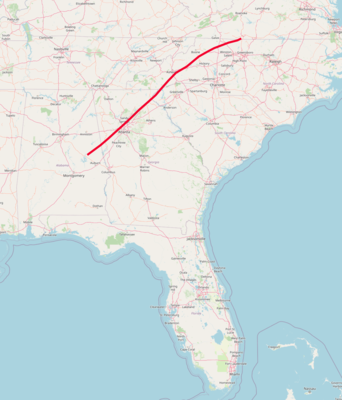
The Brevard Fault Zone is a 700-km long and several km-wide thrust fault that extends from the North Carolina-Virginia border, runs through the north metro Atlanta area, and ends near Montgomery, Alabama. It is an important Paleozoic era feature in the uplift of the Appalachian Mountains.
Discovery
Arthur Keith from the United States Geological Survey first identified an exposed segment of the Brevard Fault in 1905, believing it to be a syncline. In 1932, Anna Jonas Stose’s used local petrology to identify the site as a thrust fault. Stose, the first to trace the fault, is also credited with identifying that the rocks in the area must have been formed through deformation, placing the Brevard Fault in a regional perspective. Using modern methods of seismic reflection and high-resolution profiling, geologists have since discovered that the Brevard Fault Zone has undergone both thrust and strike-slip movement.
Geology
The Brevard Fault Zone is a part of a much larger system of faults at the base of the Appalachian thrust sheet that played a key role in uplifting the Appalachian Mountains. The extent of its role remains uncertain because most of the fault is buried beneath Quaternary sediment. Many studies of the fault come from Grandfather Mountain in the Linville Fall Quadrangle, which contains the exposed region that was first discovered by Arthur Keith. This region is only 1–3 km of its 700 km length.
The Brevard Fault experienced multiple phases of deformation and minimal stratigraphic displacement. The Brevard Fault Zone contains diverse lithologies, but it is primarily composed of mylonitic metagraywacke, schist, amphibolite, and gneiss that underwent metamorphism 350–360 million years ago. The Fault Zone is characterized by ductile behavior as indicated by the widespread presence of mylonitic and phyllonitic rocks.
See also
Bibliography
- Robert D. Hatcher; Matthew T. Huebner; Justin R. Rehrer; Louis L. Acker; Paul D. Fullagar; Angang Liu; Patricia Lee Goad (11 September 2017). Geologic and kinematic insights from far-traveled horses in the Brevard fault zone, southern Appalachians. Vol. 213. doi:10.1130/2017.1213(13). ISBN 978-0-8137-8213-3. Wikidata Q61122687.
{{cite book}}:|journal=ignored (help) - Nikolas I. Christensen; Daniel L. Szymanski (1988). "Origin of reflections from the Brevard Fault Zone". Journal of Geophysical Research. 93 (B2): 1087. Bibcode:1988JGR....93.1087C. doi:10.1029/JB093IB02P01087. ISSN 0148-0227. Wikidata Q105127624.
- Thomas J. Crawford; Jack H. Medlin (1 October 1973). "The western Georgia Piedmont between the Cartersville and Brevard fault zones". American Journal of Science. 273 (8): 712–722. Bibcode:1973AmJS..273..712C. doi:10.2475/AJS.273.8.712. ISSN 0002-9599. Wikidata Q105128412.
References
- ^ Alain Vauchez (1987). "Brevard fault zone, southern Appalachians: A medium-angle, dextral, Alleghanian shear zone". Geology. 15 (7): 669. Bibcode:1987Geo....15..669V. doi:10.1130/0091-7613(1987)15<669:BFZSAA>2.0.CO;2. ISSN 0091-7613. Wikidata Q59666174.
- Robert D. Hatcher (2001). "Rheological partitioning during multiple reactivation of the Palaeozoic Brevard Fault Zone, Southern Appalachians, USA". Geological Society, London, Special Publications. 186 (1): 257–271. Bibcode:2001GSLSP.186..257H. doi:10.1144/GSL.SP.2001.186.01.15. ISSN 0305-8719. Wikidata Q105126340.
- ^ Bobyarchick, Andy (1999). "The history of investigation of the Brevard fault zone and evolving concepts in tectonics". Southeastern Geology. 38 (3): 223–238.
- Dietrich, R. V. (1974). "Memorial to Anna I. Jonas Stose" (PDF). Geological Society of America. Archived (PDF) from the original on 2019-02-09.
- Jonas, Anna Isabel (1932). "Structure of the metamorphic belt of the southern Appalachians". American Journal of Science. s5-24 (141): 228–243. doi:10.2475/ajs.s5-24.141.228. ISSN 0002-9599.
- Gore, Pamela J. W.; Witherspoon, William D. (2013). Roadside Geology of Georgia. Missoula, Montana: Mountain Press Publishing Company. p. 187. ISBN 978-0-87842-602-7. OCLC 872634030.
- ^ Hatcher, Robert D.; Huebner, Matthew T.; Rehrer, Justin R.; Acker, Louis L.; Fullagar, Paul D.; Liu, Angang; Goad, Patricia Lee (2017). "Geologic and kinematic insights from far-traveled horses in the Brevard fault zone, southern Appalachians". Linkages and Feedbacks in Orogenic Systems: Geological Society of America Memoir. 213: 313–351. doi:10.1130/2017.1213(13). ISBN 9780813712130.
- Reed, Jr., John C. (1964). "Geology of Linville Falls Quadrangle North Carolina" (PDF). Geological Survey Bulletin. 1161-B: B3.
- "Mineral Resources Online Spatial Data". USGS. Archived from the original on 2018-06-25.